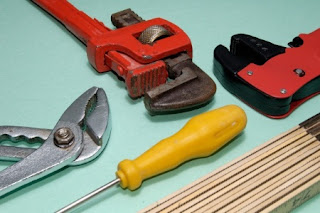I had an interesting time playing a “back line”
set. It was a high quality set – very complete – but with a few weak
points. The main issues were the hi-hat, snare and bass pedal. Wait a minute ...
aren't those the most important tools for a drummer? With a part missing from
the hi-hat, a jammed snare release and a bass pedal badly in need of some
grease, I had to be vigilant just to 'TCB' which, of course, takes away from
playing music and my mental health.
What helped drive home this message came the very next day when I spent a
half hour working on a stool I'd loaned to a friend. Had he set up the stool
correctly, it would not have been damaged and I wouldn't have had to get out the
tools and fix it.
Remember when you were a kid and your parents kept telling you to take better
care of your stuff? That was good advice. And with drums, as with most things,
it's easier to keep things from falling apart prematurely than to fix them after
the fact.
All drum hardware is well engineered. The designers continually look at what
drummers need and then do their best to come up with a solid solution — one that
could last for years and years. But in the end, it's up to us to understand and
work with those solutions.
Here's another example. I bought a fancy, highly rated bass pedal, but I
found it rather disappointing. So I went online and looked for hints and
comments. What I found was a video by the pedal's designer explaining and
demonstrating the pedal's design principles. It took no time at all to get the
pedal to where I wanted it ... once I understood the ideas behind the
technology. (Drum and hardware makers often have online videos and tutorials to
help you understand their equipment.)
It may take a bit of time and perhaps some research to figure out how your
hardware works. But it's well worth getting to know all the features that were
put there for your benefit. And then you should use them properly. This means
thinking about how the thing works, how it goes together, what can fail and why.
It also means operating the item within its design range.
So choose hardware suited to the job, learn how it works, try not to abuse
it, and see to repairs at the first sign of trouble. Aside from saving time,
money and aggravation, it may very well save the day when an inadequate or
poorly maintained part might have broken down at the worst possible time and
place. I suggest you treat your drums at least as well as you treat your car.
Subscribe to:
Post Comments (Atom)
Losing My Dream ... or When one door closes
I wasn't always obsessed with drums. I managed to get half-way through my teen years before becoming addicted. Then I jumped in with bo...

-
The bass drum has a long and colourful history. When not being used to send long distance messages or intimidate an enemy, it's long b...
-
When I entered university many years ago, I’d become interested in studying the invisible forces that drive human behaviour. And so I major...
-
Of all the traditional snare drum rudiments, two have had more than their share of drama. The Drag and the Ruff (a.k.a. Dragg, Rough) have ...




No comments:
Post a Comment